KAMRA™ Inlay
The KAMRA™ inlay treatment is an exciting new eye procedure that restores near vision and frees you from the constant frustrations of reading glasses. The KAMRA inlay sits in the first few layers of the eye known as the cornea. Smaller and thinner than a contact lens, the KAMRA inlay is a mini-ring with an opening — or pinhole — in the center. The inlay uses this pinhole to focus light coming into the eye. This restores near vision while maintaining distance vision.
Pepose Vision Institute is proud to be the first practice to implant the KAMRA in Missouri and the bi-state area.
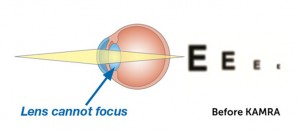
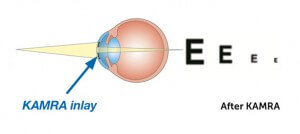
KAMRA treats near vision loss
In our 40s and 50s, we begin to experience the naturally frustrating effects of blurry near vision. Reading the newspaper, seeing the computer screen or sending a text message becomes a struggle. We end up depending more and more on reading glasses or contact lenses to see up close. This natural loss of reading vision is called presbyopia, and it eventually affects all of us, even if we never needed vision correction before.
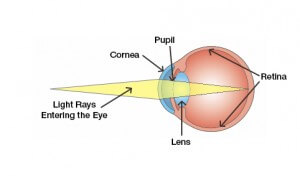
What Causes Presbyopia?
The eye’s natural lens is normally elastic and flexible. It works like a camera lens to automatically adjust and focus our vision. This lets us automatically switch our gaze from something near to something far away. Over time, the lens in your eye begins to stiffen. It can’t bend into the right shapes to bring close objects into clear focus. To compensate, you end up moving objects further away to help your eye to focus. Presbyopia continues to progress over time. For example, someone who is 45 may only notice it when trying to read tiny print in low light. However, someone who is 50 may need to use reading glasses many times throughout the day.
How does the KAMRA inlay help?
The KAMRA inlay treatment is an eye procedure that restores near vision and frees you from the constant frustrations of reading glasses. The KAMRA inlay sits in the first few layers of the eye known as the cornea. Smaller and thinner than a contact lens, the KAMRA inlay is a mini-ring with an opening — or pinhole — in the center. The inlay uses this pinhole to focus light coming into the eye. This restores near vision while maintaining distance vision.
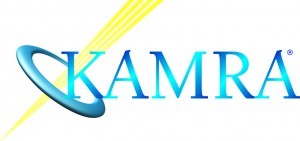
We frequently offer free seminars where you can learn about the KAMRA inlay.
We will list current seminars here, and also send out a notification. If you aren’t on our email list, please scroll to the bottom of this page and sign up.
A word from Dr. Pepose about the KAMRA inlay.
Pepose Vision played a key role in the clinical studies to attain approval for KAMRA in the United States and is one of the first to offer this procedure in the country.
How the KAMRA™ Inlay works
Enjoy Life without Depending on Reading Glasses
The KAMRA inlay treatment is an eye procedure that restores near vision and frees you from the constant frustrations of reading glasses. It is ideal for active people looking to no longer depend on reading glasses or contact lenses for their everyday activities.
The KAMRA inlay:
• Restores everyday vision so you can see text messages, a computer screen and the time on your wrist watch, without the frustration of reading glasses
• Provides a natural range of vision – from near to far – without blurry zones
• Offers a long-term solution that will help you enjoy clear near vision over time
How the KAMRA Inlay Works
The KAMRA inlay sits in the first few layers of the eye known as the cornea. Smaller and thinner than a contact lens, the inlay is a mini-ring with an opening – or pinhole – in the center. This pinhole allows only focused light to enter your eye. The KAMRA inlay is placed in only one of your eyes, allowing you to see up close, while maintaining your distance vision in both eyes. Your non-KAMRA eye is left untouched. Working together, the eyes allow you to see near to far. This is unlike monovision laser vision correction, which corrects one eye for near and one eye for distance and does not last over time.

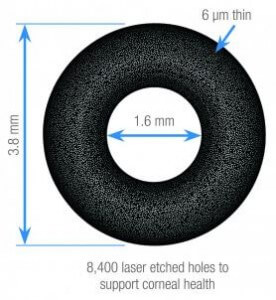
The KAMRA™ Procedure
The Procedure
From start to finish, the KAMRA procedure will typically take less than 20 minutes. Numbing drops are used to ensure you are comfortable throughout the procedure. You may feel slight pressure while our surgeon uses a laser to create a small opening in the first few layers of your eye, known as the cornea. However, it only lasts a few seconds. The inlay is then placed within the opening. Once the numbing drops wear off, your eyes may feel irritated or scratchy and you may also experience excessive tearing or light sensitivity. This is normal. We will provide medications to help you manage these symptoms.
You will not be able to drive home following the procedure so make arrangements beforehand for a ride. You should not drive until your doctor tells you that this is okay.
Recovery
As with any eye surgery, healing is a process. Adhering to our recovery instructions will accelerate your progress. It is important to remember that the amount and pace of near vision improvement varies by individual. While some patients see an improvement within the first week to a month, others may require additional time to heal. Most patients resume normal activities and return to work within 24-48 hours.
To enhance your recovery and near vision improvement, you should:
• Avoid using your reading glasses
• Take your medications as prescribed, including artificial tears
• Keep your follow-up appointments with us
It is typical to experience some fluctuations in your vision in the first three to six months after surgery. This is often a sign of dry eye or your brain adapting to the new vision. These will likely stabilize. The keys to success are to be patient with the recovery process and diligent in following our instructions.
Keep in mind that some KAMRA patients may still require reading glasses for activities such as reading tiny print or reading in low light. In addition, if the inlay is not centered properly or if the effects are not ideal, we can safely remove the KAMRA Inlay.
Comments from actual KAMRA™ Inlay patients
Questions and Answers
Following are answers to common questions. To learn more about the KAMRA and see if it’s right for you, please schedule an appointment with us.
How long does the KAMRA Last?
The KAMRA inlay does not wear out. It gives long term help with your vision throughout your life once it is placed for most patients. It does not cause a cataract, but it also does not prevent you from getting the cataract that all senior citizens ultimately get. The KAMRA inlay is not removed at the time of cataract surgery, but is left in place so that it can help you read without glasses even after the cataract removal.
The inlay provides life long benefits. Having said that, it is comforting to know that the inlay can be removed if you desire.
What material is used to make the KAMRA inlay?
The KAMRA inlay is comprised of a proven biocompatible material frequently used in a wide variety of eye and other medical implants, called polyvinylidene fluoride. In addition, the inlay has been tested and implanted safely in thousands of eyes.
How big is the KAMRA inlay?
Smaller and thinner than a contact lens, the inlay is a film-like ring with an opening in the center. The inlay is 3.8mm in diameter with a 1.6mm opening in the center. It is 5 microns thick (or the thickness of a red blood cell and one tenth the thickness of a sheet of paper).
Will I feel the KAMRA inlay in my Eye?
A contact lens sits on the outside of your eye and moves about so you can feel it. The KAMRA inlay is in the cornea where it does not move and there have been no reports of a patient feeling the inlay. This is one of the great advantages of the procedure as compared to contact lens use.
Will people be able to see the inlay in my eye?
Depending on the size of your pupil, color of your eye, and the lighting conditions, the KAMRA inlay is virtually invisible.
Will the KAMRA inlay darken my vision?
The inlay is designed to help your eye focus the light so images and text look clear again. Right after the inlay is implanted, you may notice some dimness, but as you adapt to the inlay, there will be little to no dimness noticed.
Will the inlay decrease my peripheral vision?
The inlay does not affect your side, or peripheral vision.
Does the inlay move in my eye?
The inlay does not move once it is placed in the eye as it instantly adheres to the corneal tissue.
How new is the KAMRA inlay?
KAMRA is not a new technology. Thousands of people including eye doctors are choosing KAMRA as their preferred near vision treatment.
Will I notice an immediate improvement?
Your recovery will depend on your personal healing patterns. While some patients see an improvement within the first week to a month, others may require additional time.
How much of an improvement can I expect?
The amount of near vision improvement varies by individual. However, most patients can expect their near vision to improve an average of three lines or more on an eye chart.
How soon after the surgery can I resume normal activities?
Most patients resume normal activities and return to work within 24 hours. We will discuss your specific recovery process with you in more detail.
Will I still need to wear reading glasses?
The goal of the inlay is to reduce your dependency on reading glasses. You may still need magnification if you are working in dim light, performing a near task for prolonged period of time or reading tiny print.
How can I achieve the best results?
You can aid your healing process by using post-op medications and artificial drops as prescribed. Furthermore, you can accelerate your visual recovery by regularly performing reading exercises we provide and not using reading glasses when performing near tasks.
Do I really need to come back for a post-op check-up?
As with any surgery, post-op checkups are very important. We will want to follow your progress. While we do not anticipate any, some postoperative issues are only detected by special assessments and may go unnoticed by the patient.
Is it normal to experience blurry vision or fluctuations?
Yes, it is common to experience these symptoms on and off during the first 3 to 6 months. This is often a sign of dry eye or your brain adapting to the new vision. Use your eye drops and give your eyes frequent breaks.
What if I already had eye surgery?
If you had prior eye surgery, you may still be a candidate for KAMRA. A full assessment is needed to determine if you qualify for the treatment.
What will happen if I develop cataracts?
Should you develop a cataract, we can easily remove and replace it with an artificial lens. Your inlay will continue to provide excellent near and intermediate vision. It’s important to note that the inlay shouldn’t increase any risks associated with having the cataract removed.
Will there be better and newer treatment available in the near future?
There are always possibilities of advancements in the medical field. The benefit of the KAMRA inlay is that it can be used in conjunction with other treatments or it can be removed, allowing patients the option to take advantage of future technology development.
Am I a suitable candidate for KAMRA if I have allergies or dry eye?
Yes, you may still be an excellent candidate for KAMRA. To determine if you’re eligible we will need to assess your eyes. If you do get the inlay, it is important to follow your our recommendations when managing your symptoms.
I wear bifocals; can I still have the surgery?
Yes, depending upon the results of your clinical evaluation.
What’s your next step?
If you have difficulty seeing up close and need to use reading glasses, the KAMRA™ inlay may be a great solution. Please come see us to learn more. Our experienced doctors will use advanced diagnostics to determine if Kamra is right for you, answer all your questions and provide you with all your options.


